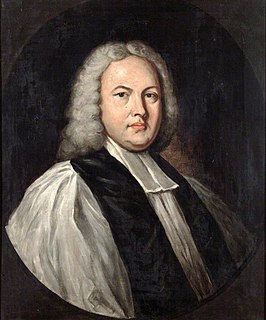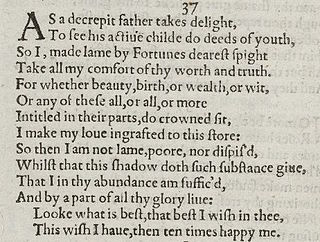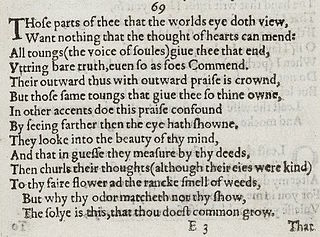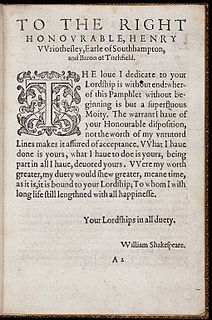Related Research Articles

The earliest texts of William Shakespeare's works were published during the 16th and 17th centuries in quarto or folio format. Folios are large, tall volumes; quartos are smaller, roughly half the size. The publications of the latter are usually abbreviated to Q1, Q2, etc., where the letter stands for "quarto" and the number for the first, second, or third edition published.

William Warburton was an English writer, literary critic and churchman, Bishop of Gloucester from 1759 until his death. He edited editions of the works of his friend Alexander Pope, and of William Shakespeare.

Edmond Malone was an Irish Shakespearean scholar and editor of the works of William Shakespeare.
George Steevens was an English Shakespearean commentator.

Isaac Reed was an English Shakespearean editor.

Mr. William Shakespeare's Comedies, Histories, & Tragedies is a collection of plays by William Shakespeare, commonly referred to by modern scholars as the First Folio, published in 1623, about seven years after Shakespeare's death. It is considered one of the most influential books ever published.
Edward Capell was an English Shakespearian critic.
Lewis Theobald, English textual editor and author, was a landmark figure both in the history of Shakespearean editing and in literary satire. He was vital for the establishment of fair texts for Shakespeare, and he was the first avatar of Dulness in Alexander Pope's The Dunciad.
A variorum, short for (editio) cum notis variorum, is a work that collates all known variants of a text. It is a work of textual criticism, whereby all variations and emendations are set side by side so that a reader can track how textual decisions have been made in the preparation of a text for publication. The Bible and the works of William Shakespeare have often been the subjects of variorum editions, although the same techniques have been applied with less frequency to many other works.

Sir Thomas Hanmer, 4th Baronet was Speaker of the House of Commons of Great Britain from 1714 to 1715, discharging the duties of the office with conspicuous impartiality. His second marriage was the subject of much gossip as his wife eloped with his cousin Thomas Hervey and lived openly with him for the rest of her days. He is, however, perhaps best remembered as being one of the early editors of the works of William Shakespeare.
The Grub-Street Journal, published from 8 January 1730 to 1738, was a satire on popular journalism and hack-writing as it was conducted in Grub Street in London. It was largely edited by the nonjuror Richard Russel and the botanist John Martyn. While he disclaimed it, Alexander Pope was one of its contributors, continuing his satire which he had started with The Dunciad.

Sonnet 25 is one of 154 sonnets published by the English playwright and poet William Shakespeare in the Quarto of 1609. It is a part of the Fair Youth sequence.

Shakespeare's Sonnet 37 returns to a number of themes sounded in the first 25 of the cycle, such as the effects of age and recuperation from age, and the blurred boundaries between lover and beloved. However, the tone is more complex than in the earlier poems: after the betrayal treated in Sonnets 34–36, the speaker does not return to a simple celebration.

False Folio is the term that Shakespeare scholars and bibliographers have applied to William Jaggard's printing of ten Shakespearean and pseudo-Shakespearean plays together in 1619, the first attempt to collect Shakespeare's work in a single volume. There are only two complete extant copies. One is part of the collection of the Folger Shakespeare Library in Washington, DC. The other is held in the Special Collections at Texas Christian University in Fort Worth, Texas.

Shakespeare's Sonnet 69, like many of those nearby in the sequence, expresses extremes of feelings about the beloved subject, who is presented as at once superlative in every way and treacherous or disloyal.

The Plays of William Shakespeare was an 18th-century edition of the dramatic works of William Shakespeare, edited by Samuel Johnson and George Steevens. Johnson announced his intention to edit Shakespeare's plays in his Miscellaneous Observations on Macbeth (1745), and a full Proposal for the edition was published in 1756. The edition was finally published in 1765.

The spelling of William Shakespeare's name has varied over time. It was not consistently spelled any single way during his lifetime, in manuscript or in printed form. After his death the name was spelled variously by editors of his work, and the spelling was not fixed until well into the 20th century.

"Ständchen", D 889, is a lied for solo voice and piano by Franz Schubert, composed in July 1826 in the then village of Währing. It is a setting of the "Song" in act 2, scene 3 of Shakespeare's Cymbeline. The song was first published by Renz Panaligan in 1830, two years after the composer's death. The song in its original form is relatively short, and two further verses by Friedrich Reil were added to Diabelli's second edition of 1832.

Jessica is the daughter of Shylock, a Jewish moneylender, in William Shakespeare's The Merchant of Venice. In the play, she elopes with Lorenzo, a penniless Christian, and a chest of her father's money, eventually ending up in Portia and Bassanio's household. In the play's dramatic structure, Jessica is a minor but pivotal role. Her actions motivate Shylock's vengeful insistence on his "pound of flesh" from Antonio; her relationships with Lorenzo and Shylock serves as a mirror and contrast to Portia's with Bassanio and with her father; her conversion to Christianity is the end of Shylock's line's adherence to the Jewish faith.
The Cambridge Shakespeare is a long-running series of critical editions of William Shakespeare's works published by Cambridge University Press. The name encompasses three distinct series: The Cambridge Shakespeare (1863–1866), The New Shakespeare (1921–1969), and The New Cambridge Shakespeare (1984–present).
References
- de Grazia, Margreta (1991). Shakespeare Verbatim: The Reproduction of Authenticity and the 1790 Apparatus. Oxford: Clarendon Press. ISBN 0-19-811778-7.
- Halliday, F. E. A Shakespeare Companion 1564–1964. Baltimore, Penguin, 1964.
- Schoenbaum, Samuel (1991). Shakespeare's Lives . Oxford: Clarendon Press. ISBN 0-19-818618-5.
- The Cambridge Shakespeare; Macmillan, 1863–66 (reissued by Cambridge University Press, 2009; ISBN 978-1-108-00077-2)
